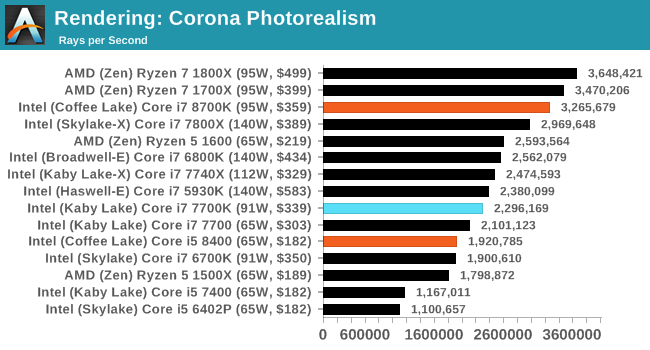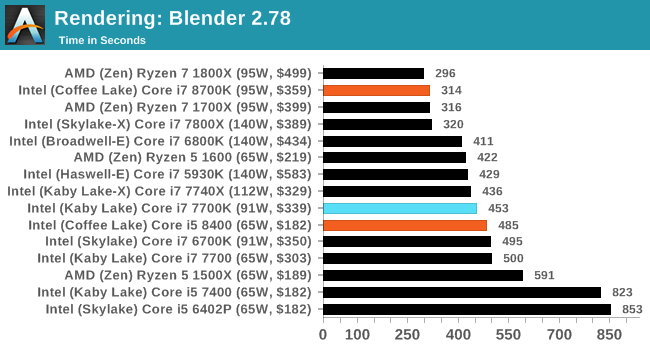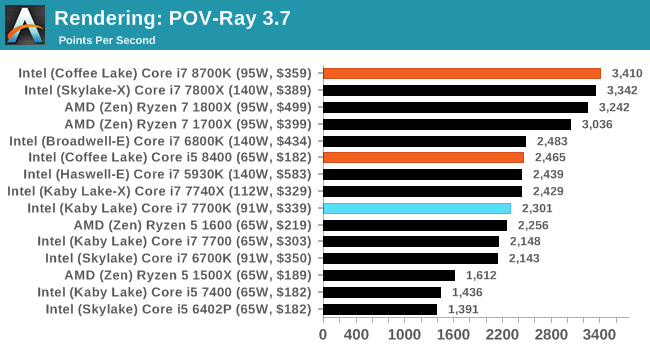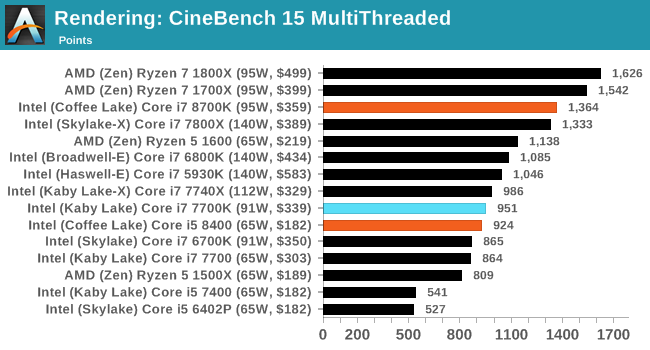The AnandTech Coffee Lake Review: Initial Numbers on the Core i7-8700K and Core i5-8400
by Ian Cutress on October 5, 2017 9:00 AM EST- Posted in
- CPUs
- Intel
- Core i5
- Core i7
- Core i3
- 14nm
- Coffee Lake
- 14++
- Hex-Core
- Hyperthreading
Benchmarking Performance: CPU Rendering Tests
Rendering tests are a long-time favorite of reviewers and benchmarkers, as the code used by rendering packages is usually highly optimized to squeeze every little bit of performance out. Sometimes rendering programs end up being heavily memory dependent as well - when you have that many threads flying about with a ton of data, having low latency memory can be key to everything. Here we take a few of the usual rendering packages under Windows 10, as well as a few new interesting benchmarks.
All of our benchmark results can also be found in our benchmark engine, Bench.
Corona 1.3: link
Corona is a standalone package designed to assist software like 3ds Max and Maya with photorealism via ray tracing. It's simple - shoot rays, get pixels. OK, it's more complicated than that, but the benchmark renders a fixed scene six times and offers results in terms of time and rays per second. The official benchmark tables list user submitted results in terms of time, however I feel rays per second is a better metric (in general, scores where higher is better seem to be easier to explain anyway). Corona likes to pile on the threads, so the results end up being very staggered based on thread count.

With more threads on display, the Core i7-8700K gets ahead of the previous mainstream Core i7 parts. The frequency difference over the Skylake-X processor gives an extra +10% performance, but the 16-thread parts from AMD win out overall.
Blender 2.78: link
For a render that has been around for what seems like ages, Blender is still a highly popular tool. We managed to wrap up a standard workload into the February 5 nightly build of Blender and measure the time it takes to render the first frame of the scene. Being one of the bigger open source tools out there, it means both AMD and Intel work actively to help improve the codebase, for better or for worse on their own/each other's microarchitecture.

Blender seems to separate very nicely into core counts, with six cores from Intel matching eight cores from AMD.
LuxMark v3.1: Link
As a synthetic, LuxMark might come across as somewhat arbitrary as a renderer, given that it's mainly used to test GPUs, but it does offer both an OpenCL and a standard C++ mode. In this instance, aside from seeing the comparison in each coding mode for cores and IPC, we also get to see the difference in performance moving from a C++ based code-stack to an OpenCL one with a CPU as the main host.

POV-Ray 3.7.1b4: link
Another regular benchmark in most suites, POV-Ray is another ray-tracer but has been around for many years. It just so happens that during the run up to AMD's Ryzen launch, the code base started to get active again with developers making changes to the code and pushing out updates. Our version and benchmarking started just before that was happening, but given time we will see where the POV-Ray code ends up and adjust in due course.

Cinebench R15: link
The latest version of CineBench has also become one of those 'used everywhere' benchmarks, particularly as an indicator of single thread performance. High IPC and high frequency gives performance in ST, whereas having good scaling and many cores is where the MT test wins out.


CineBench R15 in single thread mode can take the Core i7-8700K by the horns and drag it to be the best performing chip ever tested.










222 Comments
View All Comments
masouth - Tuesday, October 10, 2017 - link
lol, he makes a comment on how SOFTWARE is written and you can't jump off YOUR bandwagon (be it Intel or Neutral) quick enough to heap your scorn.Dolpiz - Saturday, October 14, 2017 - link
https://youtu.be/oCSkyNHXIAE?t=20m48squanticchaos - Monday, February 5, 2018 - link
If you consider Ryzen does not have integrated graphics, Coffee lake beats its TDP hands down.Crono - Thursday, October 5, 2017 - link
I love the smell of coffee In The MorningIGTrading - Thursday, October 5, 2017 - link
We know that this is a "short" "pre-review", but it is a bit bizarre that there is no mention of AMD in the conclusion.Not that we consider that AMD should be necessarily mentioned in an article dedicated to an Intel launch, BUT Intel's offerings were always discussed in the conclusion section of every AMD review.
So we would consider it's just fair to remind people in the conclusion as well that the new Coffee Lake chips from Intel are a welcomed addition, but that they are unable to completely dethrone the competition and should be praised for the fact that AMD will be now forced to lower the Ryzen prices a bit.
The way it is right now, the conclusion is written like Intel is the only alternative, quad or hexa core, with nothing else on the market.
Personal opinion :
Despite me being the technical consultant on the team, this was observed by two of my colleagues (financial consultants) and they even brushed it away themselves as "nitpicking" .
Since I've worked in online media myself, this looks very similar with an attempt to post something to "play nice" with Intel's PR so we've decided to post this comment.
Therefore we eagerly await Ian's full review, with his widely appreciated comprehensive testing and comparisons.
Nevertheless, thank you Ian for your work! It is appreciated.
eddieobscurant - Thursday, October 5, 2017 - link
What did you expect, Anandtech is an intel pro review site. They didn't even mention the huge price difference between intel's z370 chipset motherboards required for coffee lake in contrast to amd's b350 chipset motherboards. It's almost double price.RDaneel - Thursday, October 5, 2017 - link
I haven't been following this closely, but does that mean that b350 boards are about $60? That's incredible! The Z370 I'm looking at is only $120, which didn't seem that bad, but if the b350s are really $60-70, then it might be worth checking out. Are they really that cheap?kpb321 - Thursday, October 5, 2017 - link
Yup. Newegg shows almost a dozen B350 boards for $60-$70 currently. Most are micro ATX but there are a couple ATX boards in that range currently (after rebate) including "gaming" boards like the MSI B350 TOMAHAWK.name99 - Thursday, October 5, 2017 - link
Really? Other times I've heard they are a pro Apple review site, a pro IBM review site, and a pro MS review site.They really seem remarkably catholic in whom they support.
seamonkey79 - Friday, October 6, 2017 - link
It depends on the article.